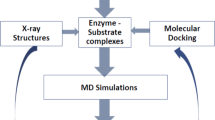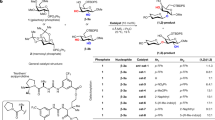Abstract
IT would appear that it is the function of enzymes to reduce the energy of activation for a given reaction. How this is effected is at present unknown. There is, however, consensus of opinion that enzyme action is initiated by a union between enzyme and substrate. Bergmann1 has advanced the theory that the enzyme protein by virtue of polar groups arranged in a pattern at its surface makes a multipoint contact with corresponding polar groups of the substrate. An intimate relationship of this kind between the interacting groups, suitably arranged in space, of enzyme and substrate may be regarded as the material basis of enzyme specificity. In most cases a single enzyme reacts with a group of substrates, though at different rates; in some cases, however, the activity of the enzyme is directed towards one substrate only. The degree of specificity of an enzyme may most properly be expressed by the decrease in the reaction velocity caused by a change in the constitution or configuration of that substrate acted upon with the highest reaction velocity (at various substrate concentrations). During the last fifteen years the effect of constitutional and configurational changes in hexoses and their glycosidic derivatives on the activity of the enzyme concerned has been extensively investigated. In view of the results of these investigations, it seems possible to derive some principles underlying enzyme specificity in the field of carbohydrates and in some instances to mark precisely the atoms or groups of the substrate which are involved in the bonding with the receiving groups of the specific enzyme protein.
This is a preview of subscription content, access via your institution
Access options
Subscribe to this journal
Receive 51 print issues and online access
$199.00 per year
only $3.90 per issue
Buy this article
- Purchase on Springer Link
- Instant access to full article PDF
Prices may be subject to local taxes which are calculated during checkout
Similar content being viewed by others
References
Bergmann, M., Harvey Lectures, 31, 37 (1936).
Cox, E. G., and Jeffrey, G. A., Nature, 143, 894 (1939).
Beevers, C. A., and Cochran, W., Nature, 157, 872 (1946).
Gottschalk, A., Biochem. J, in the press.
Helferich, B., Ergeb. Enzymforsch., 7, 83 (1938).
Pigman, W. W., âœAdvances in Enzymologyâ, 4, 41 (1944).
Weidenhagen, R., Ergeb. Enzymforsch., 1, 168 (1932).
Adams, M., Richtmyer, N. K., and Hudson, C. S., J. Amer. Chem. Soc., 65, 1369 (1943).
Hofmann, E., Biochem. Z., 272, 133, 426 (1934).
Cori, C. F., and Cori, G. T., Proc. Soc. Exp. Biol. and Med., 34, 702 (1936). Cori, G. T., Colowick, S. P., and Cori, C. F., J. Biol. Chem., 123, 375(1938).
Cori, G. T., Colowick, S. P., and Cori, C. F., J. Biol. Chem., 124, 543 (1938).
Meyerhof, O., Biochem. Z., 183, 176 (1927).
Gottschalk, A., Austral. J. Exp. Biol., 21, 133, 139 (1943).
Gottschalk, A., Austral. J. Exp. Biol., 23, 261 (1945).
Gottschalk, A., Biochem. J., 40, 621 (1946).
Gottschalk, A., Biochem. J., in the press.
Mueller, D., Biochem. Z., 205, 111 (1929).
Berger, L., Slein, M. W., Colowick, S. P., and Cori, C. F., J. Gen. Physiol., 29, 379 (1946).
Author information
Authors and Affiliations
Rights and permissions
About this article
Cite this article
GOTTSCHALK, A. Mechanism of Enzyme Specificity in the Domain of Carbohydrates. Nature 160, 113–115 (1947). https://doi.org/10.1038/160113a0
Issue Date:
DOI: https://doi.org/10.1038/160113a0
Comments
By submitting a comment you agree to abide by our Terms and Community Guidelines. If you find something abusive or that does not comply with our terms or guidelines please flag it as inappropriate.



